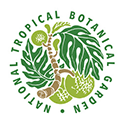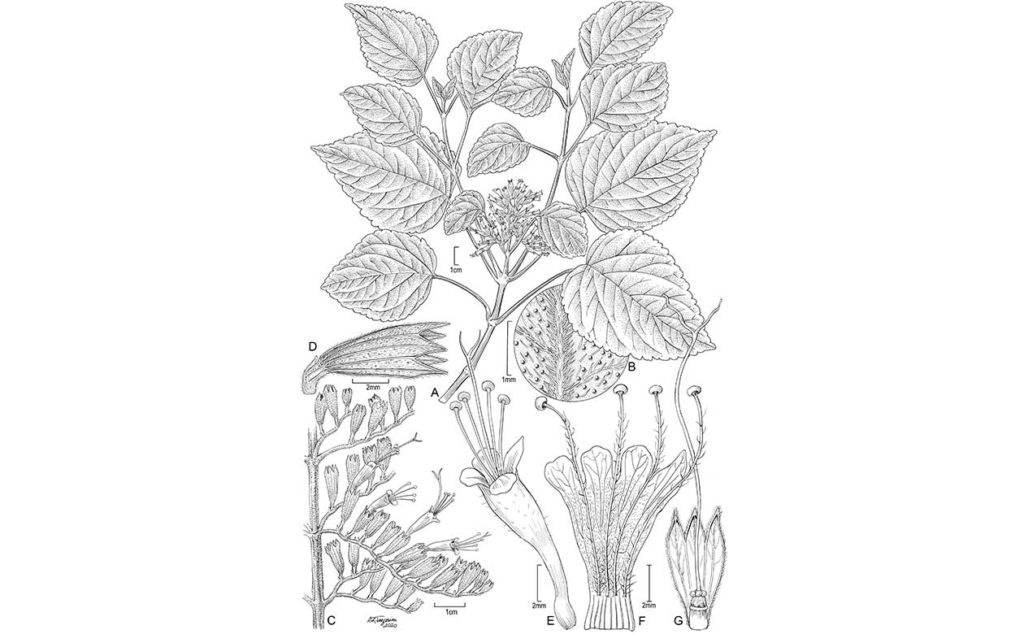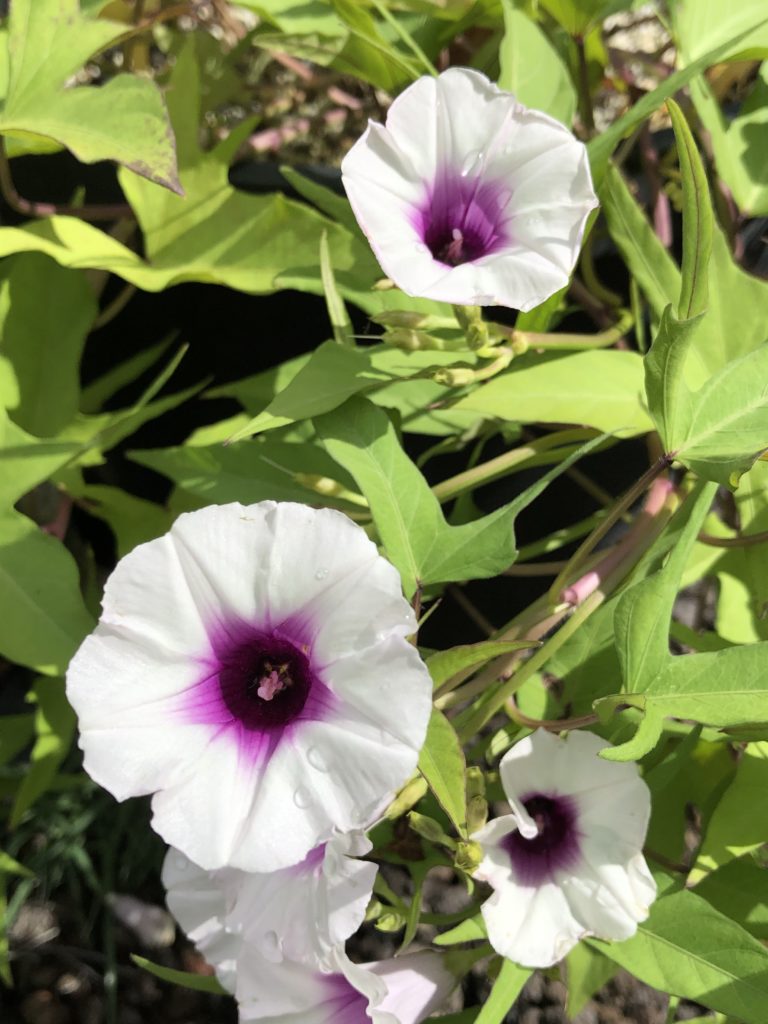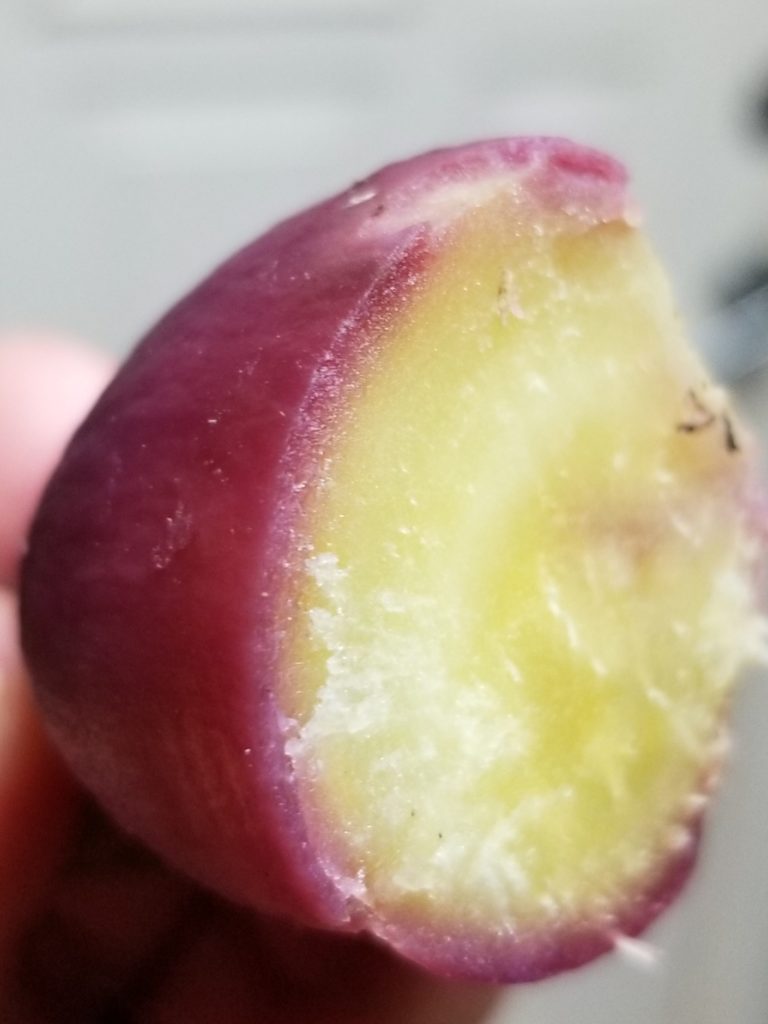Saving the Kamakahala of Kauai
by Kenneth R. Wood, Research Biologist
Botanists and enthusiasts of the Hawaiian flora may recognize the genus Geniostoma by its older name, Labordia, or by its melodic Hawaiian name kamakahala. The genus includes Geniostoma helleri, a divinely beautiful and Critically Endangered Kauai endemic tree species in the Logania family. Long ago, the seed of the original founder was likely carried to the Hawaiian Islands by a bird. Over millennia, kamakahala evolved in isolation into a lineage of 19 extraordinarily unique taxa, eight of which are federally listed as endangered, each a masterpiece of evolution.
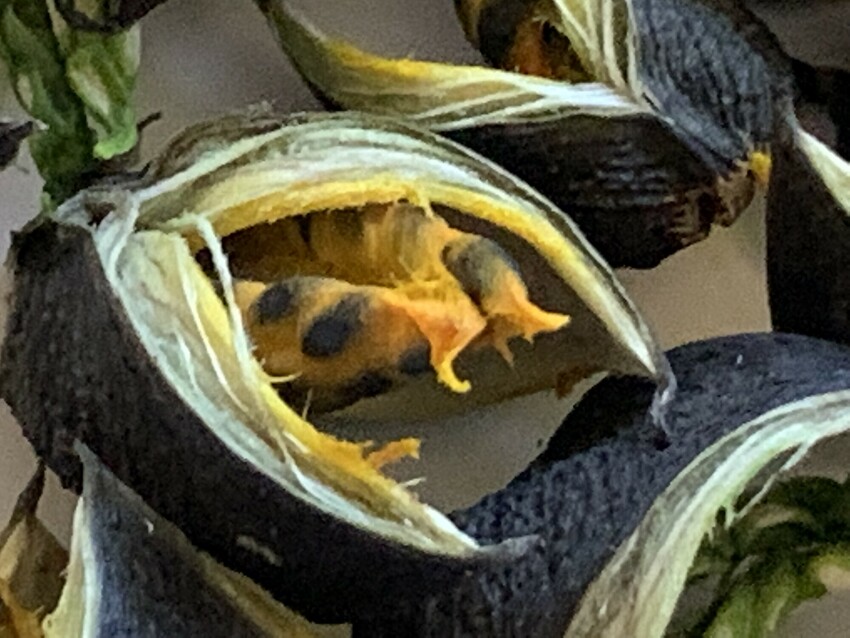
The conservation of kamakahala can be difficult since plants are either male or female and require the presence of both sexes in the colony. Insect visitation of flowers is also needed for pollen exchange. Where there are highly fragmented and separate individuals, biologists need to gather pollen from males and hand-pollinate the isolated female when she is with receptive flowers.
Over the last few decades, NTBG’s Science and Conservation team has mapped all seven species of kamakahala on Kauai, including over 100 Geniostoma helleri individuals throughout Kokee’s mesic forests and Kauai’s western canyons. This phytogeographical (referring to the geographical distribution of plants) knowledge of distribution and abundance has been fundamental in our conservation efforts, and we are thrilled to report that we have exceeded our expectations for the conservation of G. helleri.
In the spring of 2021, collections were made from five separate female trees, with one of those collections rendering over 1,000 seeds, the total number of seeds collected for this project increased to approximately 2,800. These are by far the best collections we’ve ever acquired from Geniostoma helleri. Portions of seed are being cultivated by NTBG’s Horticulture team, and significant numbers are being preserved in our seed storage facility under the curation of seed bank and laboratory manager Dustin Wolkis.
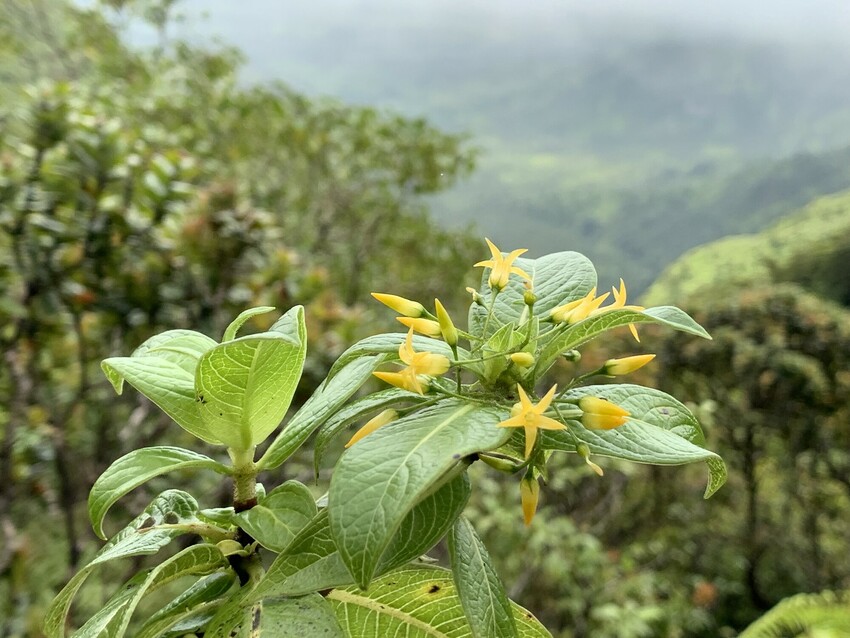
Another single-island endemic kamakahala on Kauai is Geniostoma lorencianum. In the early 1990s, while searching with entomologists in remote interior canyons for the rare endemic fabulous green sphinx moth (Tinostoma smaragditis), NTBG staff discovered a new species of kamakahala which was described and ultimately named in honor of Dr. David Lorence, NTBG’s senior research botanist.
Only a single colony of this kamakahala species has ever been found, which included three males and one female tree. Lorence’s kamakahala is a wonderful example of inter-agency conservation. The collaborative efforts of NTBG, along with the Kauai Plant Extinction Prevention Program (PEPP), and the Hawaii State Division of Forestry and Wildlife (DOFAW) have resulted in successful seed collections of G. lorencianum, followed by nursery propagation, and finally reintroduction back into the forests where the species was originally discovered. Many dozens now occur in their natural habitat and are protected within a fenced exclosure from goats and pigs. DOFAW has made great efforts to maintain that exclosure.
In Kauai’s rugged, wet windward and northern forests, another extremely rare and strikingly beautiful kamakahala occurs. Named in honor of Reverend John Mortimer Lydgate (1854-1922), Geniostoma lydgatei has exquisitely delicate flowers and the smallest fruit capsules of any kamakahala. Geniostoma lydgatei also occurs in the Upper Limahuli Preserve where NTBG biologists are methodically mapping and monitoring individuals and have been collecting seed for conservation.
During the spring and summer of 2021, PEPP and NTBG have made significant observations of Geniostoma lydgatei in lowland wet ohia forest, but this extraordinary species is still only known from several hundred individuals. NTBG plans to maintain and enhance viable populations of this federally endangered species in the fenced Upper Limahuli Preserve.
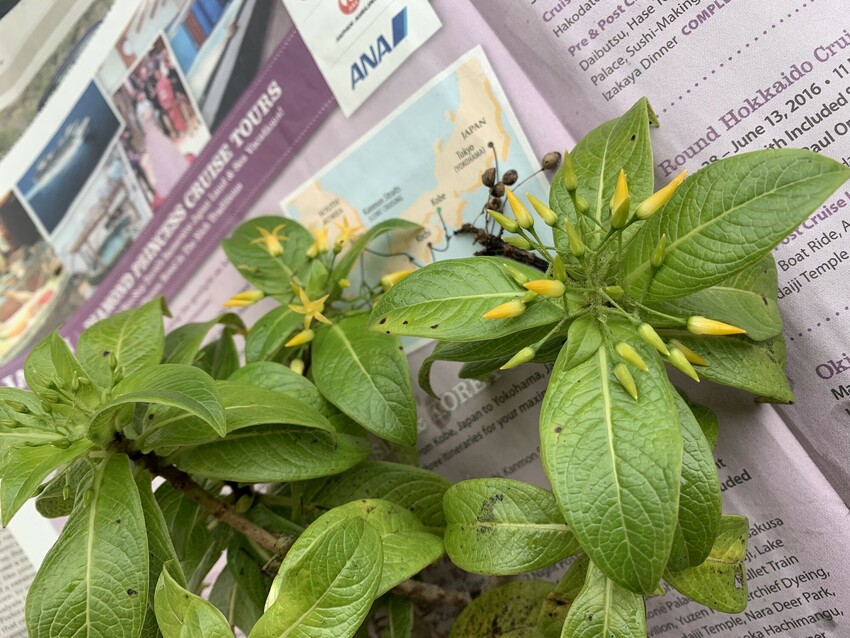
Currently NTBG’s director of science and conservation, Dr. Nina Ronsted, has partnered on a National Science Foundation (NSF) grant to study the phylogenetic relationships and diversification of the entire Hawaiian lineage of kamakahala. The grant will also include 11 other Hawaiian plant radiations in need of molecular and taxonomic work. This NSF research is in partnership with Washington University, University of California-Los Angeles, UC-Berkeley, Smithsonian Institution, and involves several NTBG staff who will be collecting and organizing leaf material for the proposed gene sequencing.With approximately 1,300 native plant species, 90 percent of them endemic, the challenge to conserve the Hawaiian flora can be overwhelming. It’s sobering to think that around 30 Hawaiian plant species have gone extinct since 2000, raising the number of extinctions to approximately 130 species of flowering plants and ferns.
This fact should leave us with a deeper appreciation of the need for greater focus and funding to secure and build populations of the Hawaiian flora. NTBG secured a grant to conserve Geniostoma helleri from The Mohamed bin Zayed Species Conservation Fund, but further expansion of horticultural facilities, staff, and increased funding is recommended to successfully manage our endangered plants and forests. Like the concept for the Ark of Noah, we are gathering Hawaii’s rare plants together to be preserved, grown, and planted back into the wild.
Video: Breadfruit Featured on CNN’s ‘Call to Earth’
CNN’s ‘Call to Earth’ series takes you inside NTBG’s Breadfruit Institute to the Regenerative Organic Breadfruit Agroforest (ROBA) to learn how breadfruit is good for people and good for the Earth. Watch how this traditional tropical crop has inspired chefs and farmers and led to global partnerships bringing breadfruit to the world.
Watch here: https://www.cnn.com/videos/world/2021/10/25/breadfruit-hawaii-spc-intl-c2e.cnn
Biggest Plant Conservation Wins of 2021
As we enter the final months of 2021, it’s important to take stock of the progress we have made together in protecting plants and people. Thanks to you, 2021 has been a great year for NTBG and tropical plants! Here are some of the amazing things we have accomplished together.
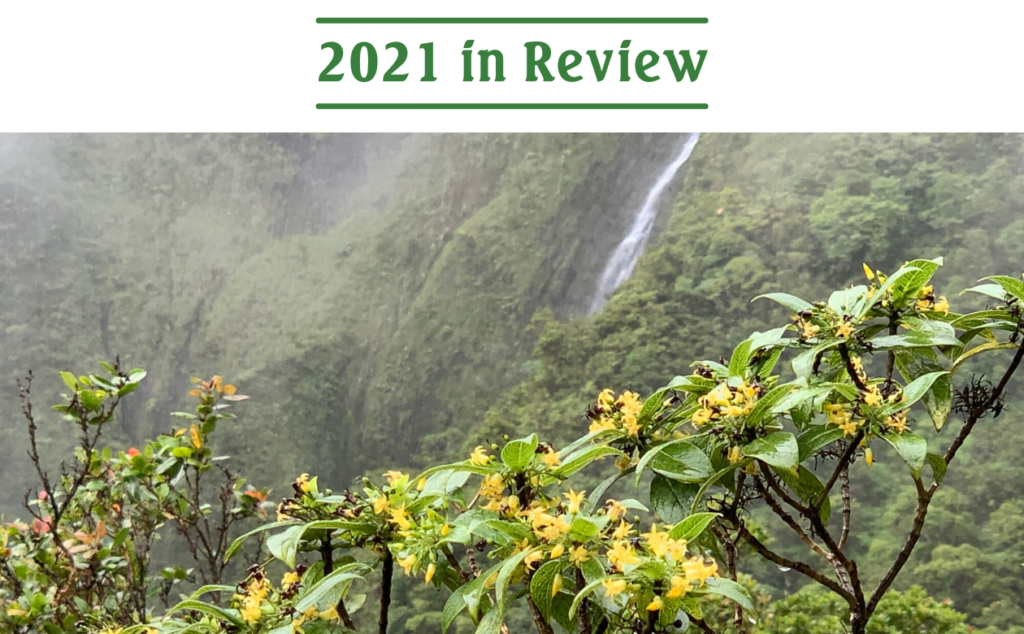
Growing Green
We’re going off the grid! Across all our gardens, we are improving our energy independence by repairing, upgrading, and installing new photovoltaic systems. Limahuli Garden even installed a water filtration system directly connected to the stream while The Kampong was able to install water bottle refill stations in an effort to reduce waste from single-use plastic. All projects were funded by our Growing Green campaign this spring, so thanks to YOU for making these projects possible.
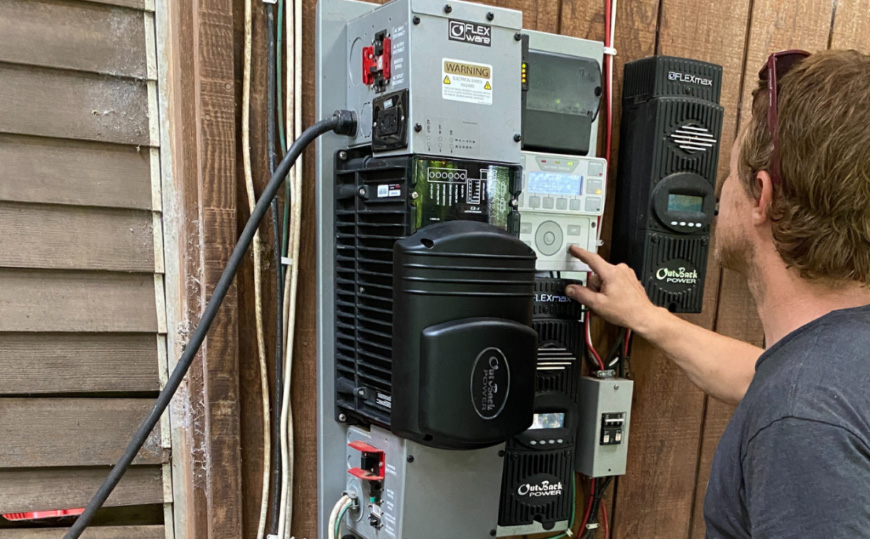
IUCN World Conservation Congress
Members of our Science and Conservation team contributed to multiple sessions, reaching around 4,000 attendees while building deeper relationships with conservation partners across the globe. NTBG coordinated and hosted a 90-minute Thematic Stream Session during the Congress on the Global Strategy for Plant Conservation (GSPC). This session was moderated by NTBG President Chipper Wichman and included conservation leaders from six different countries. It also featured our own Dustin Wolkis, Seed Bank and Laboratory Manager, who also serves as the Deputy Chair of the IUCN Seed Conservation Specialist Group.
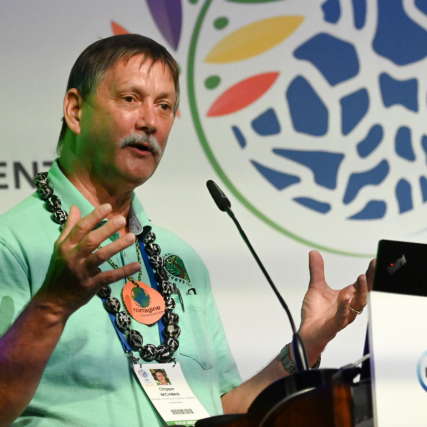
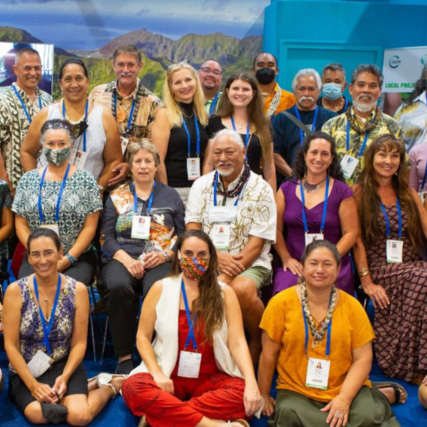
Climate Change Video Series
You helped us reach over 20,000 views of our Kauai Climate Change Series! With support from the County of Kauai, our Science and Conservation team produced five videos that provide a summary view of challenges Hawaii faces from a changing climate. Thanks for watching, sharing, and spreading the word about the challenges we face so we can better work to save plants — and people in the future. View videos.
NTBG Completes IUCN Red Listing for all Kauai Endemic Plants
Assessing endemic species across the Hawaiian Islands helps scientists and conservation managers around the world better evaluate threat risks and aid in the formulation of conservation strategies. Among the eight main Hawaiian Islands, Kauai has the highest level of endemism (species found only in one specific location) and biodiversity. Completing assessments of all Kauai single-island vascular endemic plants brings international attention to the threats they face and increases efforts to save them. Read more.

Historic Fruit Production in Upper Preserve
In the Upper Limahuli Preserve, we are seeing the literal fruits of our nearly 10 years of labor monitoring rodents in the southwest bowl. We had the largest ripe fruit collections from both Pritchardia perlmanii and Clermontia fauriei, both of which are usually decimated by rodent predation.
NTBG Receives High Level Accreditations
This summer, we were thrilled to receive accreditation from Botanic Gardens Conservation International (BGCI) as an Advanced Conservation Practitioner carrying out globally significant conservation activities. Our Living Collections team also successfully renewed the highest level IV of accreditation from The ArbNet Arboretum Accreditation Program, which recognizes international industry standards for arboreta. Read more.
Visitor Programs Thrive in Second Half of the Year
This Spring we experienced an increase in travel and garden visitors! The steady stream of traffic allowed us to bring back visitor program staff and increase capacity to welcome folks into our gardens. Whether you were experiencing the gardens for the first time or coming home, thank you so much for your support. Book a tour.

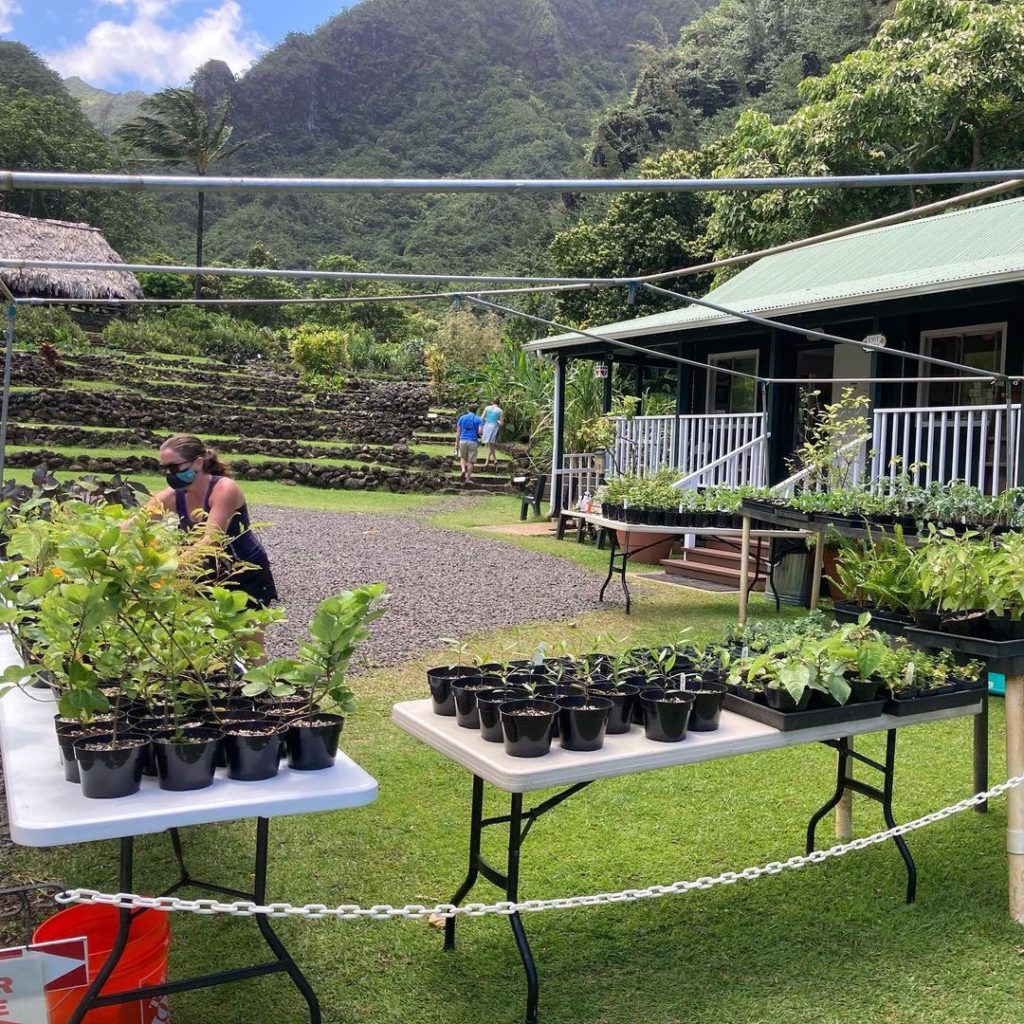
Weekly Aloha Market
Our South Shore Visitor Center took advantage of the beautiful outdoor setting to launch a weekly market. Hundreds of visitors are now able to safely explore the visitor center gardens and shop for locally made gifts, products and produce every week! Read more.
Local Plant Sales
Throughout the year, our gardens have continued to hold local plant sales, distributing over 1,500 plants to community members. A combination of native plants, ulu trees, and other desirable home gardening plants and vegetable starts were propagated and sold.
Brighamia Outplantings
Outside of the new Kahanu Garden Visitor Center, staff constructed a custom planter in an effort to cultivate and strategically hand pollinate the Critically Endangered Brighamia rockii (Alula). This plant was grown in our Conservation Nursery on Kauai before being transported by NTBG staff to Kahanu Garden for outplanting and hand pollinating. This project was funded in part by a grant awarded by the National Geographic Society.

Harvest Donated to Local Food Banks
Many island residents continued to struggle with food insecurity in 2021. An impressive 2 ½ tons of fresh produce were harvested from the Breadfruit Institute’s Regenerative Organic Breadfruit Agroforest and donated to the Kauai Independent Food Bank, Aloha Aina Poi Co., and the Marshallese Church of Waimea. Harvest was also made available distributed to NTBG staff, volunteers, and interns.
Plant Discoveries
Drone technology has greatly increased our ability to discover new plant populations in remote mountain terrain. NTBG drone specialist Ben Nyberg and botanist Ken Wood recently discovered 10 individuals of Kadua fluviatilis and 95 individuals of critically endangered Cyanea asarifolia on windward Kauai. Find out what else we discovered in 2021 by registering for our webinar: Celebrating New Hawaiian Plant Discoveries in 2021.
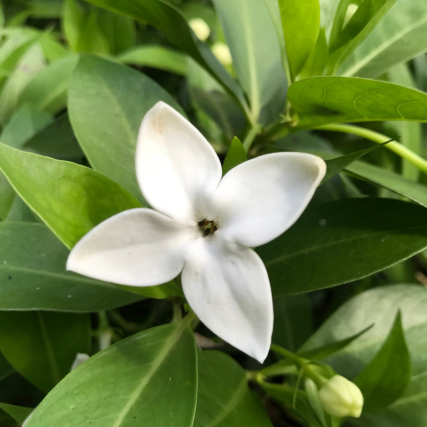
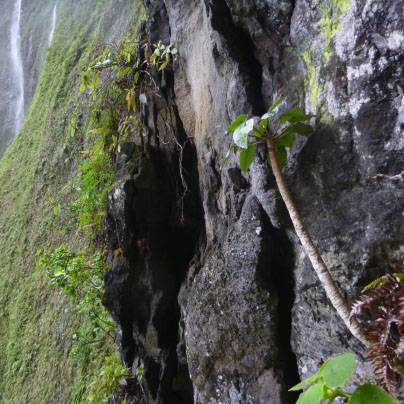
You make Saving Plants, Saving People possible! Mahalo nui for being a part of our ohana. We can’t wait to see what the rest of 2021 has in store.
Video: Cliff Dwellers of Kauai
NTBG staff and drone footage is featured alongside our partners at Hawaii’s Department of Land and Natural Resources (DLNR) /Division of Forestry and Wildlife (DOFAW) and the Plant Extinction Prevention (PEP) program in this 28-minute DLNR-produced video “Cliff Dwellers of Kauai…and the people who hang with them!”
Cliff Dwellers of Kauai…and the people who hang with them! from Hawaii DLNR on Vimeo.
Article: Preserving Hawaii’s Biodiversity Is Up To Us
The recent delisting of 23 native species in our islands is just the tip of the iceberg.
When the U.S. Fish and Wildlife Service announced plans to delist 23 species from the endangered species list due to their presumed extinction, it highlighted the importance of preserving biodiversity and supporting conservation.
Read more at: https://www.civilbeat.org/2021/10/preserving-hawaiis-biodiversity-is-up-to-us/
NTBG Receives Advanced Conservation Practitioner Accreditation From Botanic Gardens Conservation International
This month, NTBG received accreditation from Botanic Gardens Conservation International (BGCI) as an Advanced Conservation Practitioner carrying out globally significant conservation activities.
“At a time when our daily news feeds are filled with darkness, it is a delight to share this bright spot for NTBG,” said Janet Mayfield, NTBG CEO and Director. “We are so proud to receive this recognition for our work saving some of the world’s rarest plants and join a select global group of only 15 botanical gardens to date,” she continued.
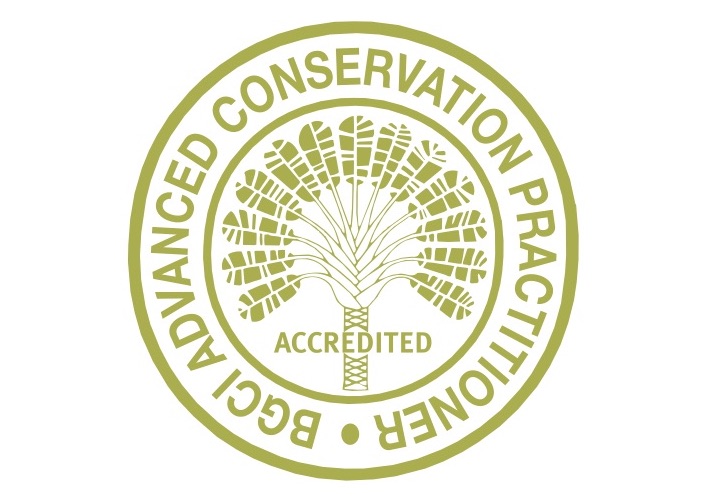
The BGCI Advanced Conservation Practitioner Accreditation is the highest level of accreditation obtainable and recognizes excellence and international leadership in plant conservation policy, practice, and education. In addition to the application, and a conservation collections assessment carried out by BGCI and an anonymous external peer review, NTBG had to provide documented evidence of:
- Compliance with international conventions
- Collections of conservation value
- Training in conservation-related disciplines offered
- Native plant species horticultural trials
- Participation in international scientific research
- Conservation activities, including In situ conservation
- Sustainability practices
- Substantial staff specialist skills
- International network membership
The collections assessment confirmed that National Tropical Botanical Garden holds 3,538 taxa in its overall collection, with 3,445 taxa in the living collection and 842 taxa in the seed bank. From the overall collection 683 taxa are unique in ex situ collections worldwide (636 unique in the living collection and 47 unique in the seed bank), and 1,765 taxa that are present in five or fewer ex situ collections globally (1,677 in the living collections and 618 in the seed bank).
Further, NTBG’s collection includes 628 taxa that are globally threatened according to the IUCN Red List of Threatened Species (595 in the living collection and 324 in the seed bank). Of these 628 taxa, 44 taxa are uniquely conserved at the National Tropical Botanical Garden (27 in the living collection and 17 in the seed bank) and 359 taxa are held in five or fewer ex situ collections worldwide (327 in the living collection and 268 in the seed bank).
Lastly, the percentage of threatened taxa in the collections of The National Tropical Botanical Garden is above average when compared with other accredited gardens. Of the 1,215 taxa that are threatened at some level (nationally, regionally or globally) according to assessments stored in the BGCI database, 67 taxa are uniquely conserved at the National Tropical Botanical Garden (41 in the living collection and 26 in the seed bank) and 574 taxa are held in five or fewer ex situ collections worldwide (523 in the living collection and 410 in the seed bank).
“This recognition really highlights the excellent curatorial standards of our living collections, the value of our collections and the importance of conservation work carried out by botanical institutions like NTBG,” said Nina Rønsted, NTBG Director of Science and Conservation
You can learn more about plant science and conservation from National Tropical Botanical Garden in a variety of ways. Review our science and conservation web pages or join us for a garden tour at one of our locations on Kauai, Maui, or in Miami, FL.
NTBG also holds the highest level IV of accreditation from The ArbNet Arboretum Accreditation Program, which recognizes international industry standards for arboreta
Four Crowd Pleasing Botanical Cocktails to Try at Home
Want to impress your guests or treat yourself to something special? Check out these four botanically-inspired cocktails that are surprisingly simple to customize with a little advanced preparation. Let your local farmers market or even your own backyard be your inspiration. These botanical cocktail recipes are versatile so grab what’s fresh and get mixin’!
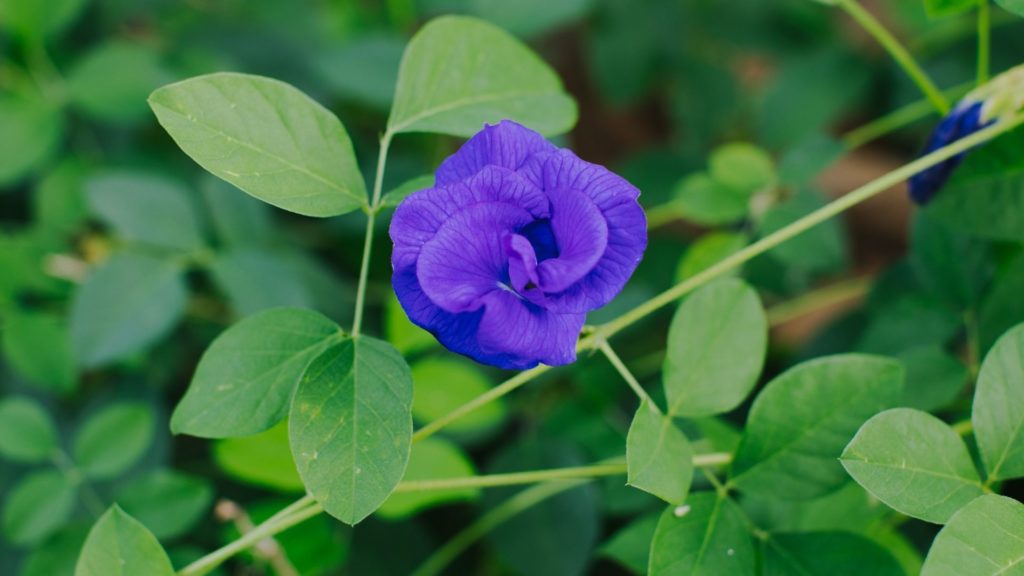
We let our Regenerative Organic Breadfruit Agroforestry (ROBA) project in McBryde Garden on Kauai inspire the ingredients for these botanical treats. More than 100 plant species and varieties are thriving in this demonstration garden which produces a year-round, environmentally sustainable harvest. Learn more about how NTBG’s Breadfruit Institute addresses critical global food security issues.
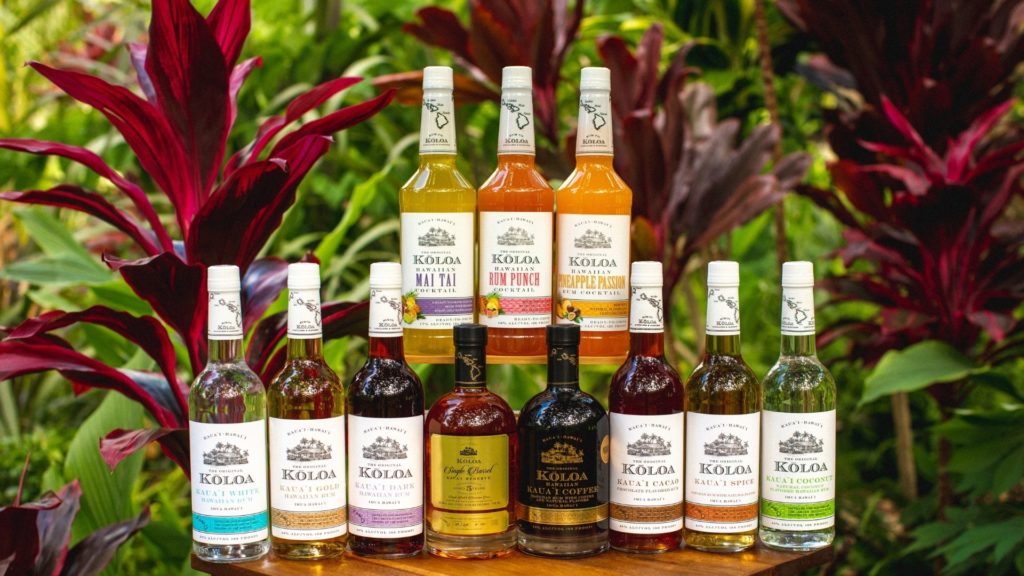
These recipes were crafted by the mixologist at Kōloa Rum Company, a local, single batch craft distiller and bottler of premium Hawaiian rums. Kōloa Rum has supported NTBG and plant conservation since 2013. Learn more about corporate sponsorship.
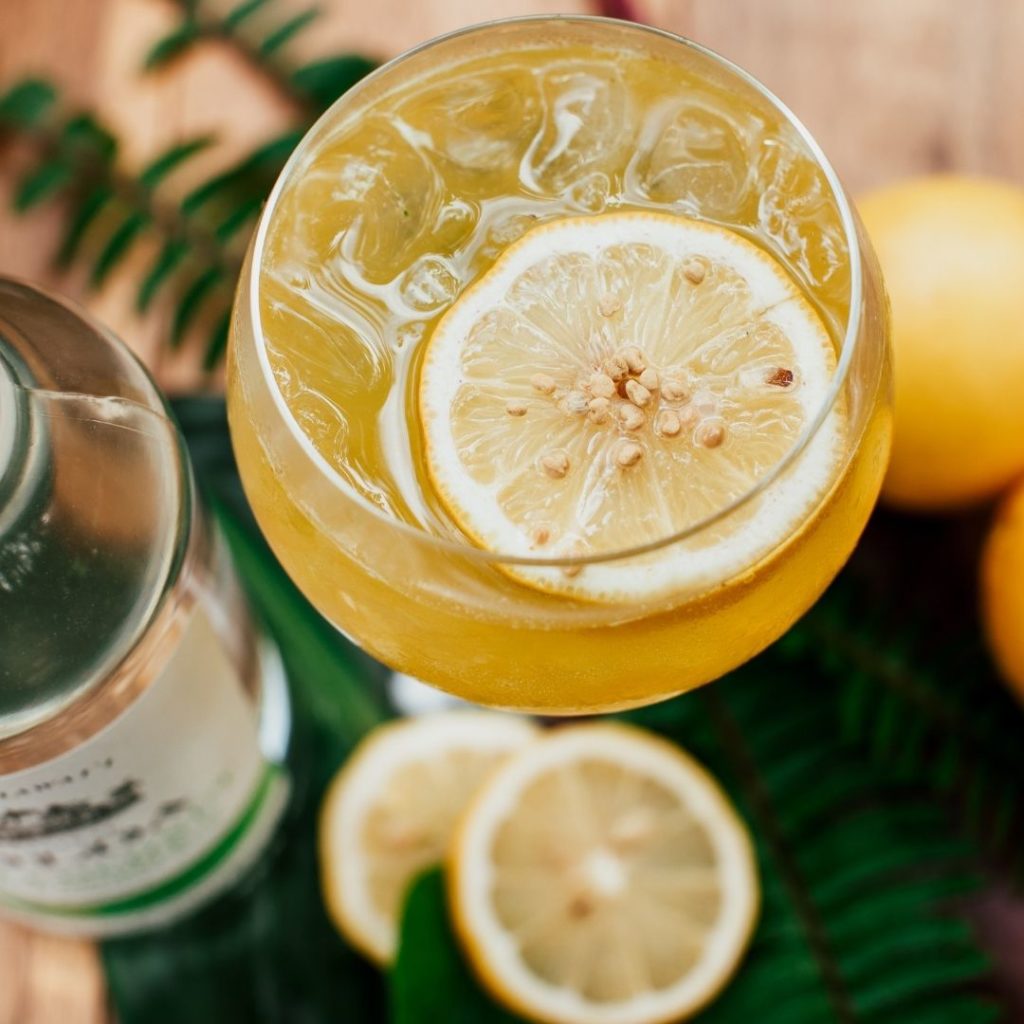
Walk in the Garden
This light and refreshing, turmeric inspired cocktail will transport you and your guests to the sunniest of gardens. Make the Sunny Shot and honey syrup in advance for an easy mix on the day. Don’t have access to fresh turmeric root? You can substitute with powdered turmeric.
¾ oz Sunny shot
1 ½ oz Honey Syrup (equal parts water and honey)
1 Kaffir Lime leaf
2 oz Kōloa Coconut Rum
Garnish: Lemon and bee pollen
Splash with 1 ½ Club Soda
Instructions: Shake Kōloa Coconut Rum, Sunny Shot*, kaffir lime leaf, and honey syrup with ice then strain into chilled glass. Top with club soda. Garnish with a lemon wheel and bee pollen
*Sunny Shot: Combine and strain ¾ cup Ginger Juice, ¾ cup Olena (turmeric) Juice, 3 cups Lemon Juice
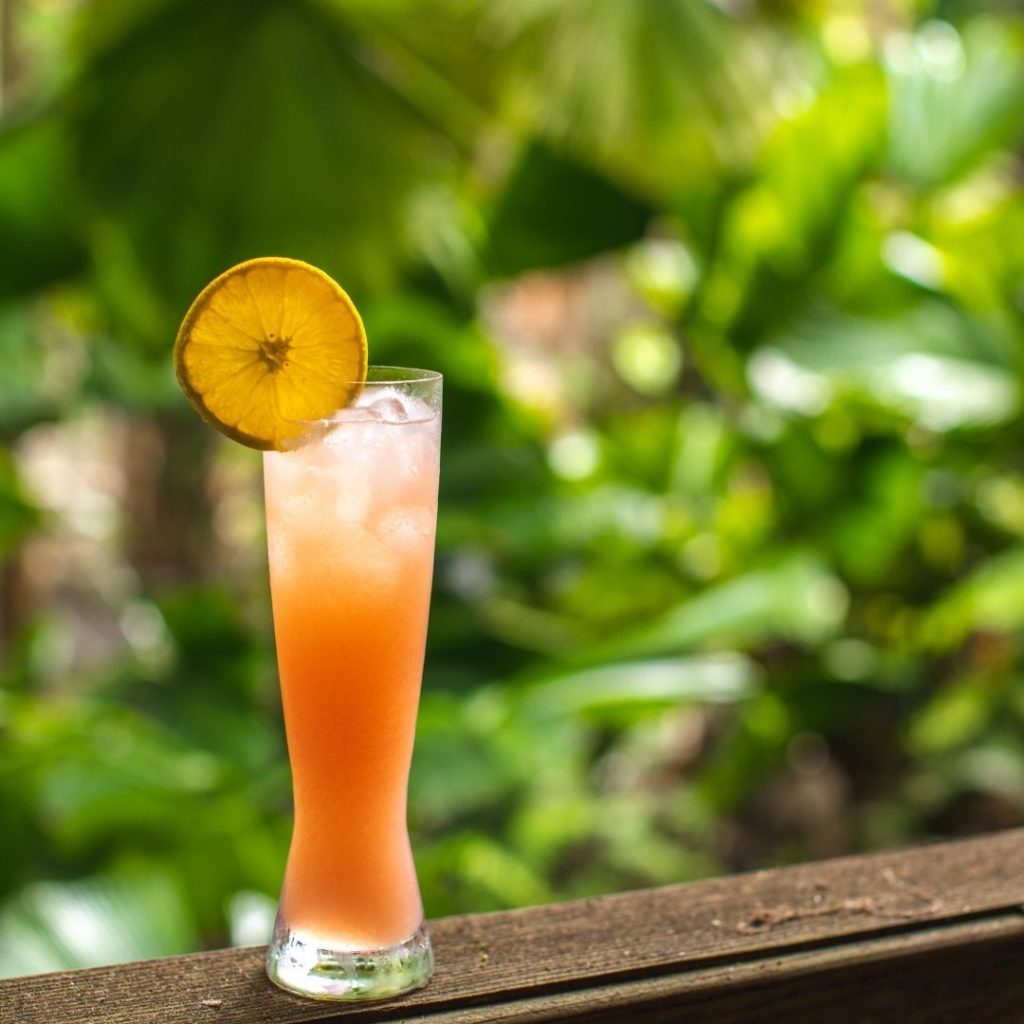
Tropical Refresher
Looking for something super simple? Then this breezy tropical refresher is for you. Fresh or canned guava juice can be used and fresh herbs like kaffir lime leaf or basil make it special.
2 oz Guava
1.5 oz Kōloa Coconut Rum
2 Kaffir Lime Leaf
Lemon/lime Soda
Garnish: Meyer lemon Wedge
Instructions: In a shaker tin, combine Kōloa Coconut Rum, guava juice, and kaffir leaves then muddle about 5 times. Pour into glass, add ice and splash with lemon lime soda. Garnish with a lemon wedge.
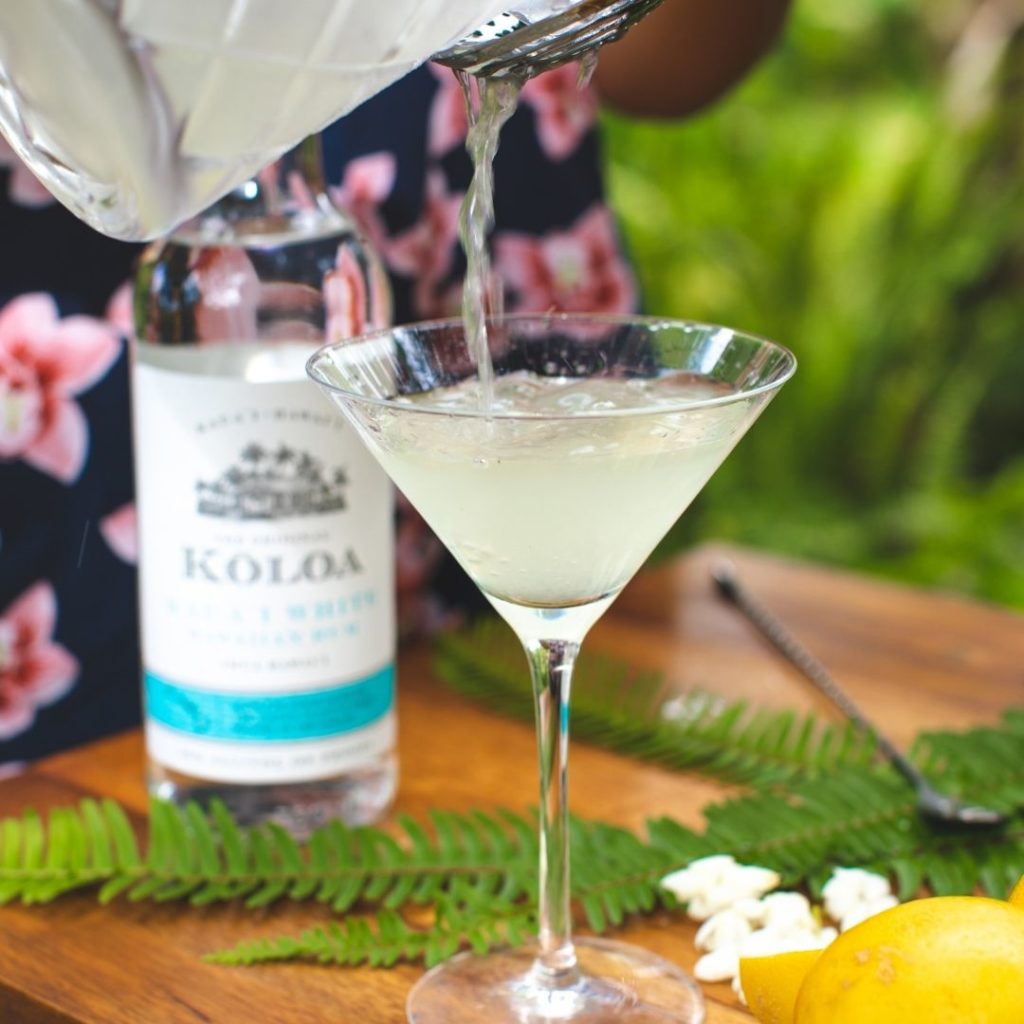
Gardenia Treasures
This floral masterpiece will truly wow your guests, and the gardenia lemonade is surprisingly easy to compile. If you’re not sure where to find gardenias, other edible flowers like jasmine (pikake), hibiscus and lavender are all excellent substitutions. Kōloa White Rum complements vanilla, spicy green notes as well as rich creamy scents.
3oz Gardenia Lemonade*
1 ½ oz Kōloa White Rum
Garnish: White petals
Instructions: Stir ingredients in a mixing glass and strain in a chilled coupe glass.
*Gardenia Lemonade: Equal Parts lemon juice, gardenia simple syrup** and water.
**Gardenia Syrup: soak 5-10 gardenias in a pint of simple syrup for 10 hours then remove flowers.
Lychee Dream Shifter
This amazing color-shifting cocktail occurs naturally from the Bluebell Vine flower (Clitoria ternatea). The flowers are commonly used as a natural, vibrant blue food coloring but changes to a lovely purple when citrus is added. The dreamy colors are a beautiful surprise that will wow your guests. We added fresh juiced lychee, a fan favorite here on Kauai.
2 oz Kōloa Coconut Rum
1 oz Bluebell Simple Syrup*
1 oz Fresh Lychee Juice strained
Squeeze Lemon Juice (Approx. 1 oz)
Garnish: Bluebell Vine Flower
Instructions: Build in shaker. Shake all ingredients with ice and strain into martini glass. After enjoying the beautiful blue color, squeeze lemon juice and stir, watch the color shift to a mysterious purple.
*Bluebell Simple Syrup: 2 cups sugar to 2 cups distilled water and 5 Blue Bell Flowers. Bring water to a boil, add sugar and flowers, stir until sugar is dissolved. Remove from heat and leave flowers in steeping until the desired color is reached.
An Eye On Plants: Pogostemon guamensis
By Jon Letman
Inherent in the notion of discovery is a sense of immediacy, but the truth is, quite often a plant unknown to science may be first collected many years before it is identified, recognized, and published as a “new species.” Take the Pogostemon guamensis, for instance.
First collected by botanist Derral Herbst on Guam in 1982, a second round of collections was made by NTBG botanists Steve Perlman and Ken Wood twelve years later while conducting a U.S. Fish and Wildlife Service-funded survey of the karstic limestone cliffs on Guam’s northeastern tip.
Known for their rappelling and cliff collecting skills, Steve and Ken were commissioned to spend part of spring and summer 1994 suspended by ropes exploring Guam’s jagged high cliff habitat. Steve recalls working in the blinding July heat, buzzed by Mariana crows and soaring fruit bats as they documented the then unidentified member of the Lamiaceae (mint family) in five separate sub-populations.
Upon their return to NTBG, senior research botanist Dr. David Lorence suspected the plant belonged to Position, a genus of nearly 80 accepted species with high diversity in the Indian subcontinent, but then unknown from Micronesia or other Pacific Islands. At the request of NTBG research associate Dr. Warren Wagner, a specimen was sent for DNA analysis to the Smithsonian Institution where Warren also commissioned scientific illustrator Alice Tangerini to do a line drawing.
The species holotype (representative specimen) collected by Steve and Ken is curated in the type cabinet at NTBG’s herbarium with its duplicates (called isotypes) shared with six other institutions including the University of Guam, the Bishop Museum in Honolulu, and the U.S. National Herbarium at the Smithsonian Institution.
Because of the low number of individuals (113 recorded) and its very restricted range, the species was given a preliminary IUCN assessment of Critically Endangered. The plant grows only on cliffs surrounding Andersen Air Force Base and is isolated from people, but it is thought to be threatened by invasive species, typhoons, and possibly animals such as feral pigs and deer.
Using molecular and morphological data, David Lorence, Warren Wagner, and collaborators determined the plant was in the genus Pogostemon (meaning ‘bearded stamen’) and appropriately named the species for its home island. Interestingly, unlike its relative Pogostemon cablin (patchouli) which is well-known for its pungent, musky smell, P. guamensis is scentless, like other Lamaiaceae found in Hawaiʻi.
Finally, in December 2020 Pogostemon guamensis was published in the peer-reviewed open access journal PhytoKeys. Some might ask, why did it take so long?
In the words of Dave Lorence, “The wheels of taxonomy grind slowly but very finely.” Ironically, Steve points out that not all undescribed species are published so fast. This species, like many others, was a side project, and among the 500-1,000 species across the Pacific that NTBG scientists are studying at any given time. With stretched resources and a limited number of classically trained taxonomists and experts available, publication can take years.
Pogostemon guamenis is another example of the importance of conducting field work in remote and under-studied areas, says Dave. “There are still plants out there that we hadn’t known existed until the survey work was done. It’s really important to study and name the plants before they go extinct.”
Presently, there are no known P. guamensis in cultivation and so conserving the species would require returning to its known locations to collect seeds and/or cuttings. Ken says, “Having the publication will make more people aware that this species exists and hopefully they will start conserving it.”
Figs, wasps, and fidelity
By Jared Bernard
If you were a botanist, you might think NTBG’s garden sites on Kauai are valuable because they allow for the study of Hawaiian and Polynesian plants. But NTBG also houses a multitude of plants from around the world, both living in the gardens and preserved in the herbarium. Having so many plants within reach presents a rare opportunity to delve into their stories.
Kelsey Brock, a research associate at NTBG, learned this when she spotted a fig sapling growing in the crotch of a Java plum tree in 2017. The sapling turned out to be a Watkins’ fig (Ficus watkinsiana), a non-native species not known to reproduce on Kauaʻi. Kelsey focuses on non-native plants that establish wild populations (called naturalization), especially those that could imperil Hawaiian ecosystems.
For three years, Kelsey scoured the island as a botanist with the Kauaʻi Invasive Species Committee, using NTBG’s herbarium as a reference collection and to deposit vouchers of recently introduced non-native species. She was accustomed to coming across new things, but when she encountered the wild fig, she knew something was weird.
Figs are notorious for having unique pollinator wasp requirements. Generally, plants that can establish themselves in a new environment are receptive to whatever pollinators are present. But figs and their pollinators have a special relationship based on absolute fidelity or “mutualism” in which they’re totally obligated to each other.
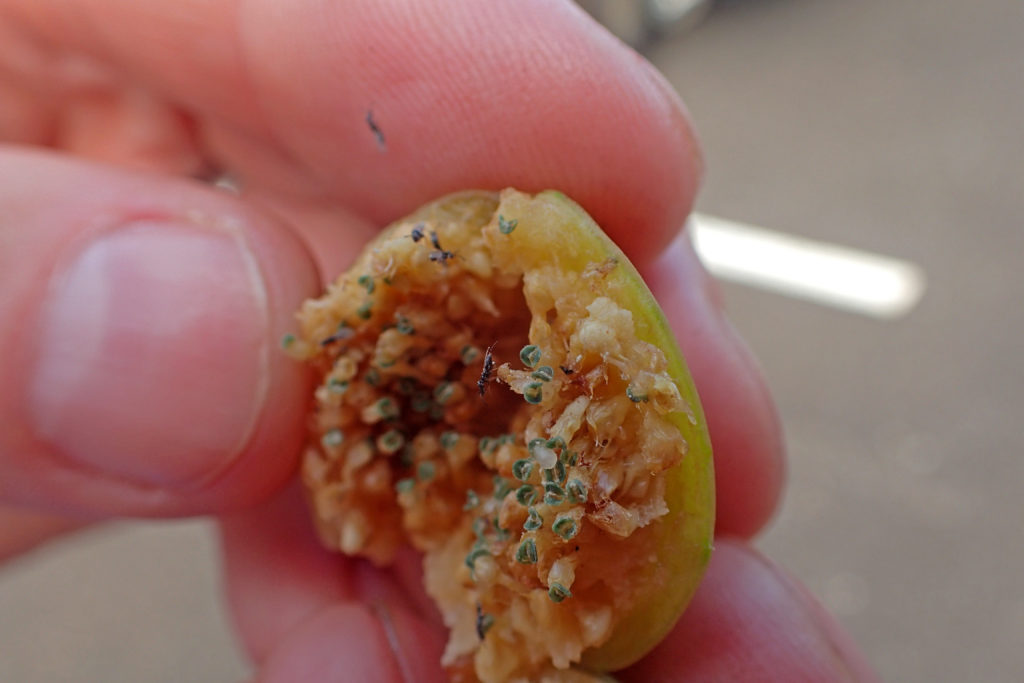
Viewing a fig tree’s flowers requires a microscope. The flowers are minuscule and hidden inside what is typically referred to as a “fig.” Pollination requires each fig species to release its own unique scent to lure its exclusive tiny pollinator wasp. The wasp must then navigate through a pinprick-sized portal on the fig, aided by its specialized head shape, to reach the flowers inside. The wasp’s goal is to put an egg in every flower so its young can get nourishment from the fig ovules. These flowers do not develop seeds, but instead tiny wasps. Some of a fig’s flower stalks are too tall, and as the wasp struggles, they get pollinated. Those flowers develop seeds that eventually become new fig trees. The fig-wasp relationship is one of absolute dependency.
Kelsey knew there were only two explanations for figs growing in the wild. Either “the fig wasp pollinators have arrived,” she said, “or the mutualism isn’t as obligate as popularly thought.” Were the figs finding new pollinators?
Solving this mystery required a closer look at the dozens of fig species on Kauaʻi. The first step was to collect figs from as many of these species as possible, whether cultivated or wild. Fortunately, NTBG’s gardens have representatives of almost all of these figs.
“NTBG’s living collection, with at least 41 mature fig species in close proximity in the Lawaʻi Valley, provided a perfect test tube to investigate these relationships,” Kelsey said. Specifically, the “living collection” includes a cornucopia of fig species in McBryde Garden, a few growing next to the Botanical Research Center, and the immense Moreton Bay fig trees (Ficus macrophylla) in Allerton Garden.
My role, as an entomologist with the University of Hawaiʻi–Mānoa, was to dissect the figs under a microscope to identify any wasps I found and collect any seeds. Most of the figs had nothing in them. But some fig species were astonishing, and every time I opened a fig, unknown things poured out. Several wasp species were not previously known to be in the Hawaiian archipelago. Emerging wasps meant they were reproducing, but what about the figs?
For the interaction to be mutual, the figs also needed to be pollinated and produce seeds. This part of the investigation required NTBG’s seed laboratory managed by Dustin Wolkis. Along with NTBG’s conservation biologist Seana Walsh, Dustin took the seeds I found and used a hi-tech germination chamber to see if they were viable. Dustin and Seana watched carefully for the seeds to sprout.
We also wanted to know whether figs were naturalizing. This was largely based on Kelsey’s island-wide surveys, but to finalize our fig collection Tim Flynn, NTBG’s herbarium curator, guided us deep into the Līhuʻe-Kōloa Forest Reserve. Tim knew a shortcut into the reserve using a trail behind his house which led us to an old road leading into the Wahiawā Mountains where we found that the Moreton Bay fig and Port Jackson fig (Ficus rubiginosa), both introduced for forestry a century ago, were starting to naturalize.
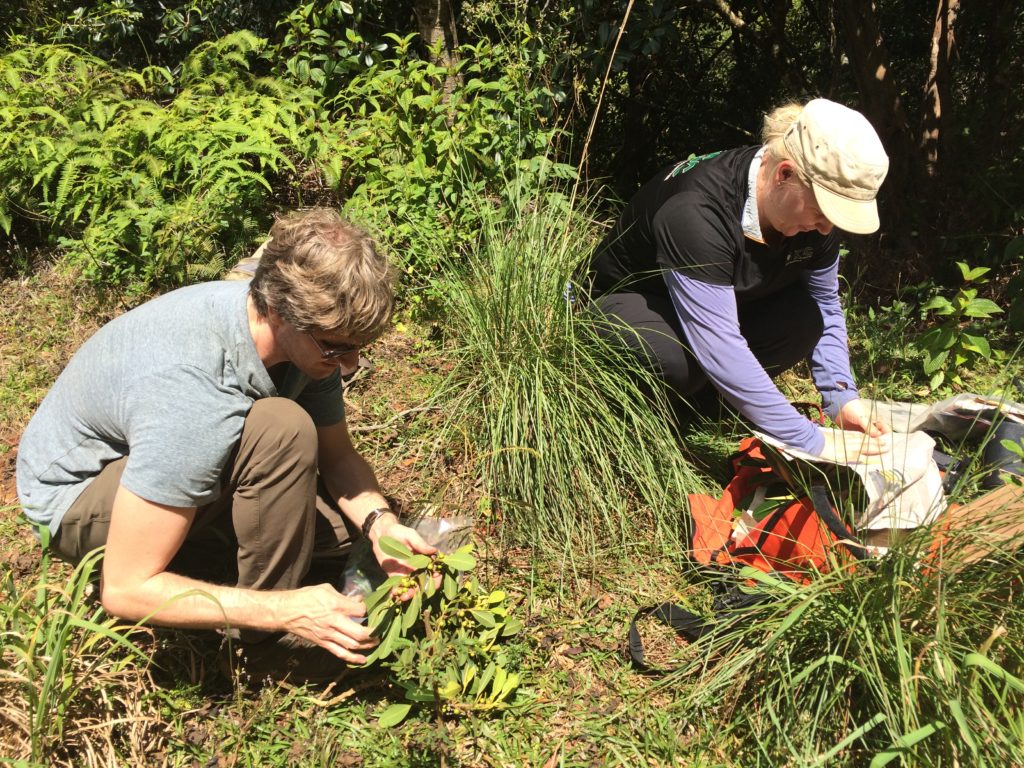
Dustin exclaimed that the fig seeds were “very much alive!” He and Seana found that all the fig species containing pollinators had sprouted little seedlings, each capable of growing into a new tree, meaning the wasps were indeed pollinating them.
Don’t forget about that initial Watkins’ fig. It too may be in an early stage of naturalizing. But while the other naturalizing figs were pollinated by their normal specific wasps, we caught the Watkins’ fig in a relationship with the pollinator of the Port Jackson fig. Both fig species are closely related and live together in their native range in Australia. No one ever found this wasp using the Watkins’ fig before, which may mean that it can’t compete with the Watkins’ fig’s normal pollinator. On Kauaʻi, however, the Port Jackson wasp (Pleistodontes imperialis) doesn’t need to contend with anyone.
We were shocked to find the Port Jackson wasp also interacting with another fig species that isn’t closely related at all: the red affouche (Ficus rubra), native to islands near Madagascar. This was among the trees we surveyed at McBryde Garden. The red affouche isn’t yet naturalizing, but with baby wasps and viable seeds, it has all the necessary ingredients. It could be only a matter of time.
To be sure these figs are sharing a pollinator, we teamed up with George Weiblen, a botanist at the University of Minnesota–Twin Cities who has studied figs for over 25 years. His lab analyzed the DNA of wasps and figs to be doubly certain of their identities.
Finding the Port Jackson wasp in the red affouche meant that it wasn’t merely hopping to close relatives. We checked other relatives of the Port Jackson fig but the wasp was absent. Something else was enabling it to interact with different fig species. By scrutinizing various fig shape dimensions, we discovered that this wasp can interact with figs whose portals have a particular shape, like a lock to which they have the key. This would be like finding out that your house key opens doors on the other side of the world.
Last November, we published our discovery in the journal Frontiers in Ecology and Evolution. We concluded that the tactics species use to maintain their unique relationships, such as figs having special shapes or wasps out-competing each other, can falter outside of their native ecosystems. The diversity of figs at NTBG’s gardens helped us understand how strict mutual relationships form, and how easy it is for them to fall apart.
Jared Bernard is an entomologist PhD candidate at the University of Hawaiʻi-Mānoa.
Uala – Hawaiian Sweet Potato
By Mike DeMotta, Curator of Living Collections
“He ‘uala ka ‘ai ho’ola koke i ka wi” – Sweet potato is the food that quickly restores health after famine
The first Hawaiian voyagers arrived in the Hawaiian Islands with approximately two dozen plants that were important enough to earn space on the crowded outrigger canoes used to cross the ocean. These ‘canoe plants,’ as they are known, were vital for providing food, fiber, medicine, and more. Many of these plants had multiple uses. Three were essential staple food crops — kalo (taro), ulu (breadfruit), and uala (Hawaiian sweet potato).
Easily propagated and grown from live cuttings or slips, uala (Ipomoea batatas) was widely cultivated on all the islands. Many communities in Hawaii’s driest areas placed great value on uala and were able to produce enough of the starchy vegetable to sustain large populations by strategically planting it during the rainy winter months and keeping it stored underground for some time after the rains had ended.
Over many generations, mahiai (Hawaiian farmers), who understood the importance of crop diversity, developed many different varieties. They cultivated these hearty, tuberous roots, protecting against total loss of any given variety and building resilience in the event of changing weather patterns or other environmental instability.
As a staple food, uala is an excellent source of vitamin C, beta carotene, potassium, protein, and minerals. The unevenly-shaped Hawaiian sweet potato is valued as a life-preserving crop, but the shoots and young leaves (called palula in Hawaiian), are also cooked and eaten. Offering great flexibility in its preparation, uala can be cooked in the same ways as other potatoes. My favorite way to enjoy uala is steamed in an imu (traditional Hawaiian underground oven). Like kalo, uala can also be mashed into a soft poi which has the consistency of thick pudding and is eaten with fish. Uala poi ferments quickly and so it must be consumed within a day or two. Grated uala cooked with coconut milk is called palau and enjoyed as a special treat.
Today there are about 24 different varieties of Hawaiian uala. Each has a distinctive leaf shape and colors of skin and flesh that range from orange and red to white. The variety Eleele literally means ‘black’ and is named for its very dark stems. Huamoa (‘chicken egg’) is a smallish, egg-shaped tuber. Inside, its darker yellow center is reminiscent of an egg yolk. Palaai (literally: ‘fat’) refers to the size of the large tubers. Piko (‘navel’) is recognized by its deeply-lobed leaves.
Mike DeMotta Inspects uala variety papaa kowahi growing outside the nursery.
Like other multi-use edible canoe plants, many uala have medicinal value. One example of uala’s medicinal use was in the concoction apu, a drink with many ingredients, but primarily made with uala. Apu has been traditionally prepared for women to be taken soon after childbirth to facilitate healing.
NTBG currently has about 20 uala varieties in our collections growing at our south shore Conservation and Horticulture Center and at Limahuli Garden on Kauai’s north shore and Kahanu Garden on Maui. We maintain all varieties within our nursery because of the challenges of growing uala in the field, namely the tenacious feral pigs who always seem to know when uala is ready to harvest. If we don’t get to them first, the pigs will complete their own harvest and never fail to eat everything, destroying all stems and leaves as they go. Growing a backup collection safely inside our nursery, helps us ensure we preserve these irreplaceable varieties.
At NTBG, we have a strategic objective to maintain collections of important Hawaiian canoe plants within our gardens. Heirloom or heritage varieties of canoe plants that are not grown commercially tend to become less common. Each named variety of canoe plant holds great importance in Hawaiian culture, whether identified in ancient legends or for its value as food and medicine. Preserving these varieties, cultivated over many generations, and the names ascribed to each, is equally important. As a key component of Hawaiian language and culture, we must remember these names which provide connections to Hawaii’s ancestors. The same uala we grow today can be traced back many generations to Hawaiian farmers of long ago, providing us with essential sources of food, medicine, and beauty, and living links to an ancient past.
The UN General Assembly has designated 2021 as the International Year of Fruits and Vegetables. The campaign provides an opportunity to increase awareness of the importance of fruits and vegetables to health, nutrition, food security, and UN Sustainable Development Goals.
